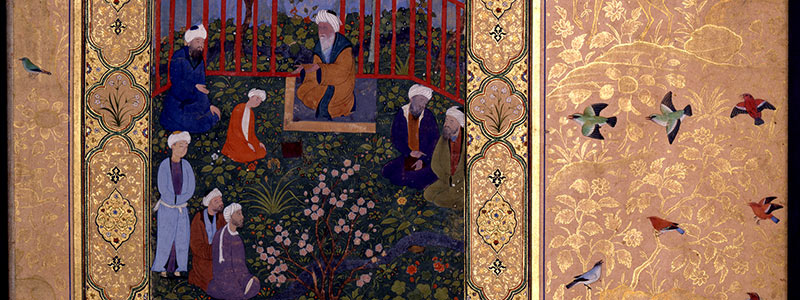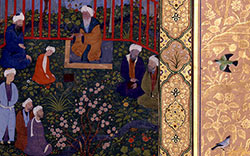Mir ‘Ali Heravi was born in Herat in 1465 CE. As a teenager, he was taught by Zayn-al-Din Mahmud and developed a keen interest in calligraphy, causing him to spend much of his time thereafter scribing. Mir ‘Ali lived in Herat until he was middle-aged, though he sometimes traveled to nearby cities such as Mashhad. This stability was interrupted in 1528 CE when ‘Obayd-Allāh Khān Uzbek occupied Khorasan and briefly brought Herat under his control. He then returned to his capital Bukhara, taking a number of artists with him, Mir ‘Ali and Shaykhzadeh Naqqāsh (“The Painter”) among them. Mir ‘Ali spent the rest of his life in Bukhara and although he sought permission to return to his hometown of Herat, he was refused.
There has been much controversy (both during and after his lifetime) about the authenticity of the works attributed to Mir ‘Ali, since many pieces were forged in his name. There are several reasons for this. First is the confusion surrounding his name itself. He had many signatures, among them ‘Ali, Mir ‘Ali, ‘Ali al-Kāteb, Mir ‘Ali al-Kāteb al-Soltāni, ‘Ali al-Hosayni, and ‘Ali al-Hosayni al-Kāteb. This is further complicated by the fact that many calligraphers of his time also bore the name ‘Ali. The second problem in verifying the authenticity of Mir ‘Ali’s works is his contemporaries’ apparent appetite for wealth and fame, which motivated a number of them to add his signature to their works. Finally, since Mir ‘Ali was not in Herat during the last years of his life, he was unable to directly confront and disgrace these opportunists. The uncertainty surrounding authenticity and authorship does not stop there. A treatise on calligraphy by the name of Medād al-Khotut (“The Instrument of Scripts”) has been repeatedly published over the centuries with Mir ‘Ali’s name on it, but is in fact a part of a book entitled Khat va Savād (“Writing and Literacy”) written by Majnun Rafiqi Heravi. Beginning with the Safavid biographers, the lives of these two great artists of the sixteenth century were mixed, a historical misstep that has been passed down through time by the biographers and historians that followed.
Mir ‘Ali produced many valuable books, such as Sa‘di’s Bostān, which he wrote in a beautiful Nasta‘liq script. These books date from 1508 to 1541 CE. Other parts of Mir ‘Ali’s precious works are included in the Golshan album (moraqqa‘). This album was compiled between 1605 and 1629 CE and includes about ninety of Mir ‘Ali’s signed works. These pieces were written between 1533 and 1544 CE. The album, which includes Mir ‘Ali’s last chalipās (which were written with a du-dāng reed pen) is kept at the Golestan Palace Library in Tehran.
Mir ‘Ali was also a poet, and some of these works, written in his own handwriting, still survive. Among Mir ‘Ali’s most distinguished students was Mahmud b. Ishāq al-Shehābi, who during his time as a student, used to forge his master’s hand. Mir ‘Ali died in 1544 CE in Bukhara.




